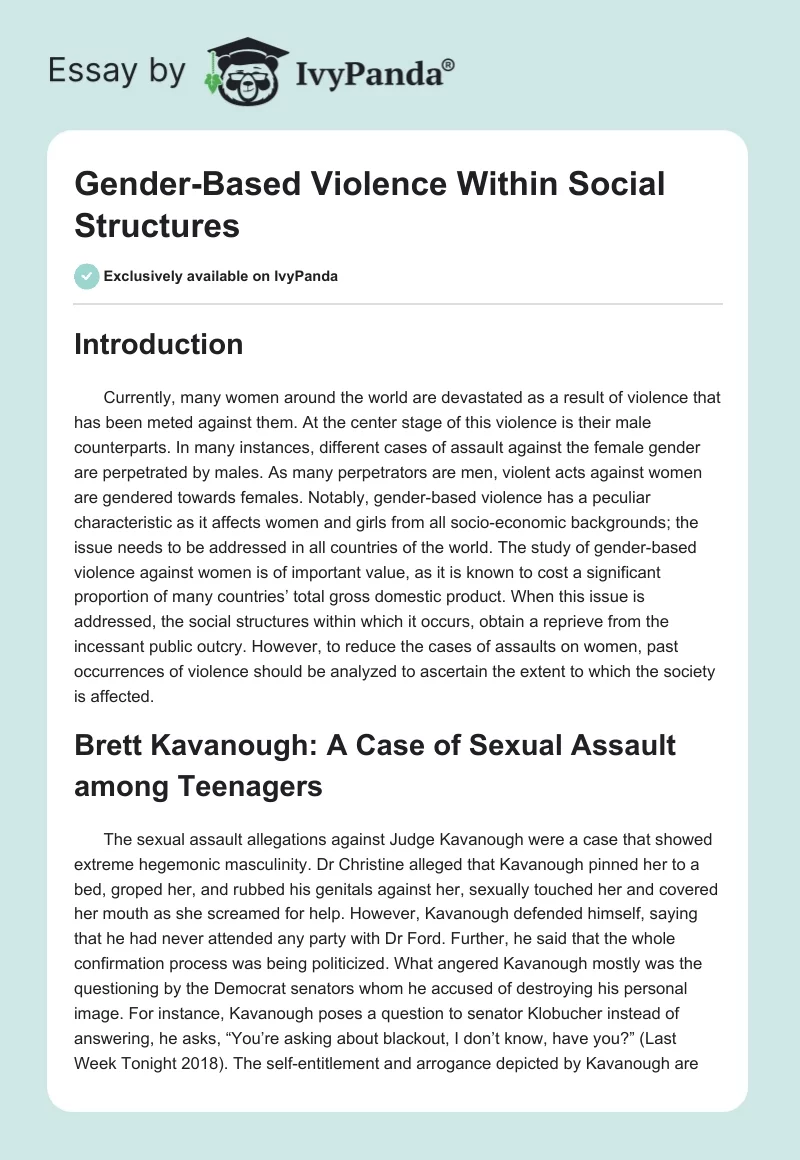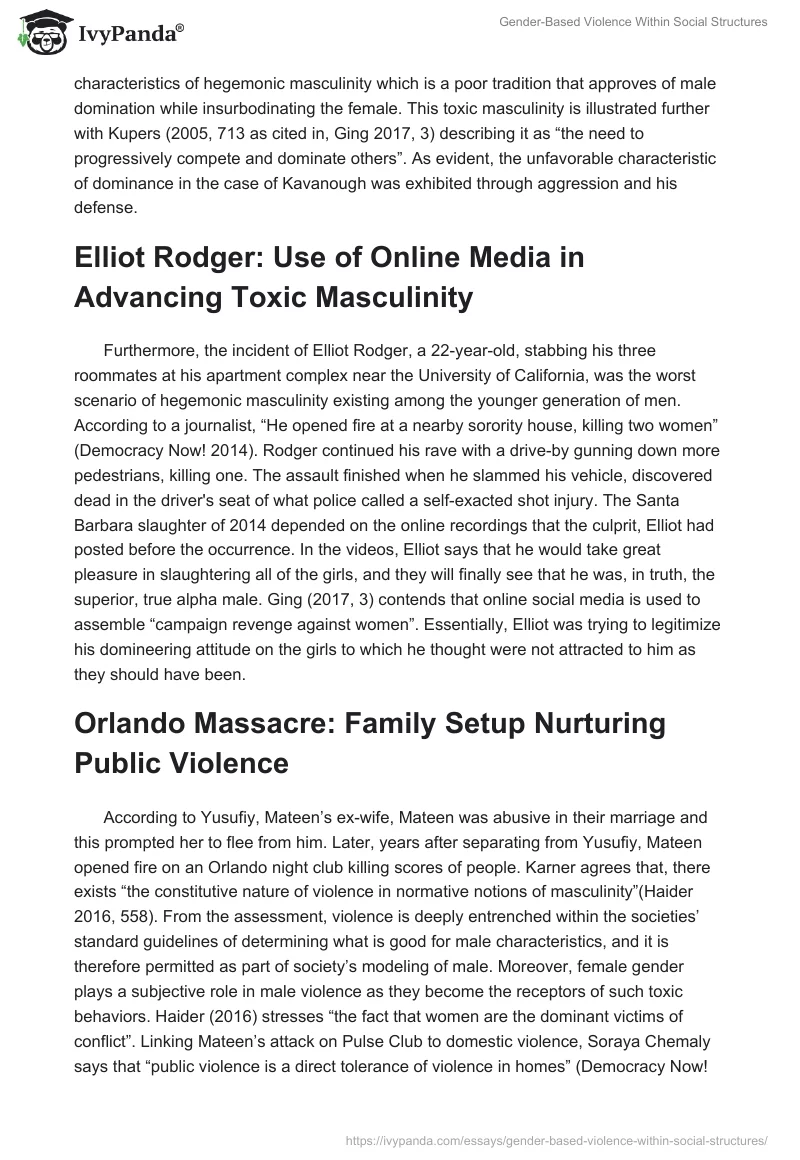- Introduction
- Brett Kavanough: A Case of Sexual Assault among Teenagers
- Elliot Rodger: Use of Online Media in Advancing Toxic Masculinity
- Orlando Massacre: Family Setup Nurturing Public Violence
- Alek Minassian: Promotion of Violence through Astern Cultures
- Emma Sulkowicz: Campaign against Rape in Columbia University
- Tracey Karner: Research on Violence Prevalence among War Veterans
- Conclusion
- References
Introduction
Currently, many women around the world are devastated as a result of violence that has been meted against them. At the center stage of this violence is their male counterparts. In many instances, different cases of assault against the female gender are perpetrated by males. As many perpetrators are men, violent acts against women are gendered towards females. Notably, gender-based violence has a peculiar characteristic as it affects women and girls from all socio-economic backgrounds; the issue needs to be addressed in all countries of the world.
The study of gender-based violence against women is of important value, as it is known to cost a significant proportion of many countries’ total gross domestic product. When this issue is addressed, the social structures within which it occurs, obtain a reprieve from the incessant public outcry. However, to reduce the cases of assaults on women, past occurrences of violence should be analyzed to ascertain the extent to which the society is affected.
Brett Kavanough: A Case of Sexual Assault among Teenagers
The sexual assault allegations against Judge Kavanough were a case that showed extreme hegemonic masculinity. Dr Christine alleged that Kavanough pinned her to a bed, groped her, and rubbed his genitals against her, sexually touched her and covered her mouth as she screamed for help. However, Kavanough defended himself, saying that he had never attended any party with Dr Ford. Further, he said that the whole confirmation process was being politicized. What angered Kavanough mostly was the questioning by the Democrat senators whom he accused of destroying his personal image. For instance, Kavanough poses a question to senator Klobucher instead of answering, he asks, “You’re asking about blackout, I don’t know, have you?” (Last Week Tonight 2018).
The self-entitlement and arrogance depicted by Kavanough are characteristics of hegemonic masculinity which is a poor tradition that approves of male domination while insurbodinating the female. This toxic masculinity is illustrated further with Kupers (2005, 713 as cited in, Ging 2017, 3) describing it as “the need to progressively compete and dominate others”. As evident, the unfavorable characteristic of dominance in the case of Kavanough was exhibited through aggression and his defense.
Elliot Rodger: Use of Online Media in Advancing Toxic Masculinity
Furthermore, the incident of Elliot Rodger, a 22-year-old, stabbing his three roommates at his apartment complex near the University of California, was the worst scenario of hegemonic masculinity existing among the younger generation of men. According to a journalist, “He opened fire at a nearby sorority house, killing two women” (Democracy Now! 2014). Rodger continued his rave with a drive-by gunning down more pedestrians, killing one. The assault finished when he slammed his vehicle, discovered dead in the driver’s seat of what police called a self-exacted shot injury.
The Santa Barbara slaughter of 2014 depended on the online recordings that the culprit, Elliot had posted before the occurrence. In the videos, Elliot says that he would take great pleasure in slaughtering all of the girls, and they will finally see that he was, in truth, the superior, true alpha male. Ging (2017, 3) contends that online social media is used to assemble “campaign revenge against women”. Essentially, Elliot was trying to legitimize his domineering attitude on the girls to which he thought were not attracted to him as they should have been.
Orlando Massacre: Family Setup Nurturing Public Violence
According to Yusufiy, Mateen’s ex-wife, Mateen was abusive in their marriage and this prompted her to flee from him. Later, years after separating from Yusufiy, Mateen opened fire on an Orlando night club killing scores of people. Karner agrees that, there exists “the constitutive nature of violence in normative notions of masculinity”(Haider 2016, 558). From the assessment, violence is deeply entrenched within the societies’ standard guidelines of determining what is good for male characteristics, and it is therefore permitted as part of society’s modeling of male. Moreover, female gender plays a subjective role in male violence as they become the receptors of such toxic behaviors.
Haider (2016) stresses “the fact that women are the dominant victims of conflict”. Linking Mateen’s attack on Pulse Club to domestic violence, Soraya Chemaly says that “public violence is a direct tolerance of violence in homes” (Democracy Now! 2016). She proposes that the media should highlight the cause and execution aspects of domestic violence cases. Chemaly says “our media tends to erase the agency and perpetration factor” (Democracy Now! 2016). Therefore family social setup acts as a ground in which violence starts and thrives.
Alek Minassian: Promotion of Violence through Astern Cultures
Masculinity is associated with retrogressive cultures that view being male as having total control over women, and females are painted as disposable creatures. A good example is Alek Minassian, a Canadian fellow, who in 2018 rammed a rented vehicle on people, therefore ending up killing many people and injuring others. In the incident, Minassian targeted pedestrians who were using the road along, Yonge Street through the North York City Centre of Ontario Canada. After he had been arrested, a police officer asked him how he felt generally towards women. In his reply, Minassian answered that sometimes he was a bit upset that women chose to date obnoxious men instead of gentlemen.
In the Minnassian case, Rebecca Solnit thinks that “it is part of a toxic brew in our culture right now that includes modeling masculinity as extremely as violence and women as worthless” (Global News 2019). Analytically, Minassian was viewing women as those creatures that he, together with other men whom he called “gentlemen”, had total right over.
Emma Sulkowicz: Campaign against Rape in Columbia University
Besides family, social gatherings, the criminal justice system, and media, institutions of learning are other social structures where gender-based violence is deeply entrenched. To illustrate, Emma Sulkowicz, a final-year female student at Columbia University was raped by another student from the same university. Sulkowicz then came up with an artwork performance in protest of the sexual assault she had faced and she resorted to carrying a mattress within the campus, to force the institution to expel the perpetrator. Oliver (2016, 86), writes, “The mattress performance called “Carry That Weight” was designed to raise awareness on campus rape”. Accordingly, the university acted in support of the initiative and subsequently the media fraternity aired the rape issue. The case is one of its kind as the campaign highlighted the violence which was meted against the females in the learning institution yet the perpetrators were not apprehended.
Tracey Karner: Research on Violence Prevalence among War Veterans
There are high societal regards for gender that portray the nature of being a man based on the social relationship the males had with their fathers and their roles upon the male children. Tracey Karner, as cited in Haider (2016, 558),
“carefully unpicks the disillusionment of a generation of young men through a social script that presented war and the military as spaces of idealized masculinity. Military service was seen as a natural rite of passage from boyhood to manhood. War movies of the era portrayed ‘war as a place of self-esteem’, proving ground of masculinity”.
The research was done by the sociologist Karner, as can be seen, regarded veterans of the Vietnam War, as heroes. In fact, entry to the military accorded the entrants the high social regard of which the characteristics of being male were viewed.
Accordingly, the relationship of male with violence is based on the gendered outlook of war in favor of males, and consequently, unpleasant male behavior came to existence. Ging (2017, 3) writes that “hegemonic masculinity may in some contexts refer to men’s engaging in toxic practices but hegemony has numerous configurations, including distancing oneself from such toxicity”. Precisely, the dominance of male gender in the society may make the men to undertake some unfavorable acts to females but it does not mean that they will totally keep away from such actions.
Conclusion
In summary, acts of gender-based violence against women are ingrained in the social structures and therefore there is a quickly minimize the cases to avoid recurrence. The US Supreme Court judge Kavanaugh’s grilling before the Senate team helps in understanding his high school teenage years, of sexual assault on women and misconduct. Additionally, the media also form part of the social structure that permits the younger generations of men like Elliot, to advance their erroneous masculine goals of meting violence on women.
Also, family as a social unit makes public violence to thrive because, within the family, violence against spouses sometimes go unreported and can escalate to massacres like the Orlando massacre of 2016. Retrogressive cultures, learning institutions, and high societal regard for masculinity are also partly to blame for the misconduct of men like Alek Minassian, and rape on Emma Sulkowicz. Therefore, different social structures have acts of gender-based violence and other forms of violence situated within them.
References
Democracy Now! 2014. ‘#YesAllWomen: Rebecca Solnit on the Santa Barbara Murder & Online Rejoinder to Misogynist Brutality’. YouTube Video, 58:56.
Democracy Now! 2016. ‘While It Goes to Orlando Massacre, Domiciliary Brutality Is the Red Light We Aren’t Speaking Of’. YouTube Video, 19:51.
Ging, Debbie. 2017. Alphas, Betas, and Incels: Theorizing the Masculinities of the Manosphere. Sage Publishers. Web.
Global News. 2019. ‘Man accused in Toronto van attack admits frustration with society, discusses Incel community’. YouTube Video, 3:38.
Haider, Syed. 2016. The Shooting in Orlando, Terrorism or Toxic Masculinity (or Both?). Sage Publishers. Web.
Last Week Tonight. 2018. ‘Brett Kavanaugh: Last Week Tonight By John Oliver (HBO)’. YouTube Video, 29:11.
Oliver, Kelly. 2016. Hunting Girls: Sexual Violence from the Hunger Games to Campus Rape. New York: Columbia University Press.


